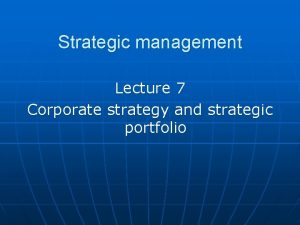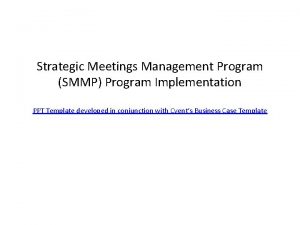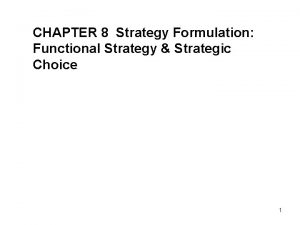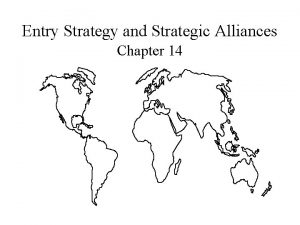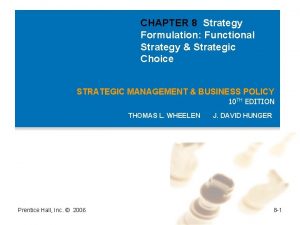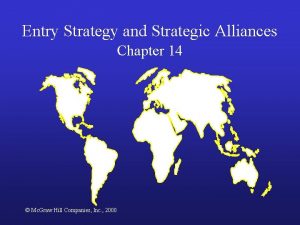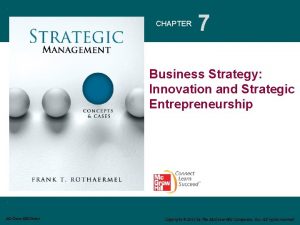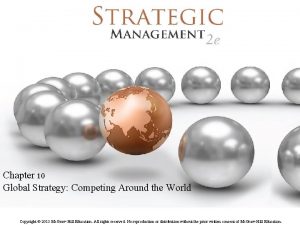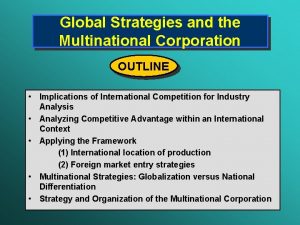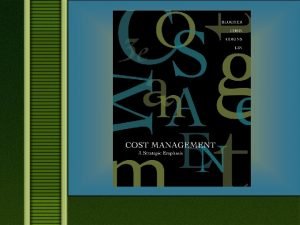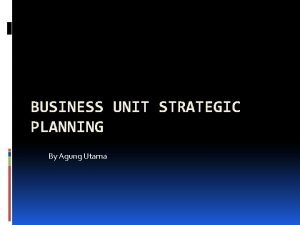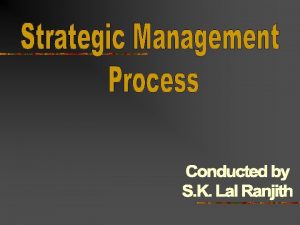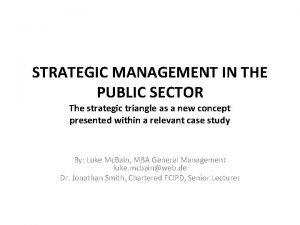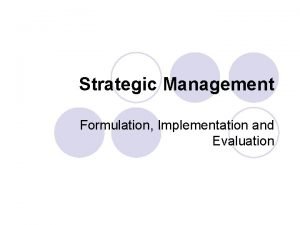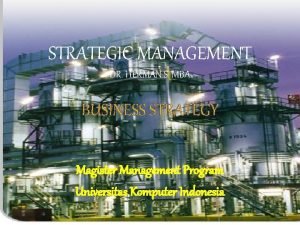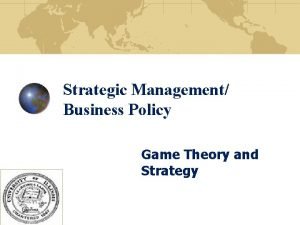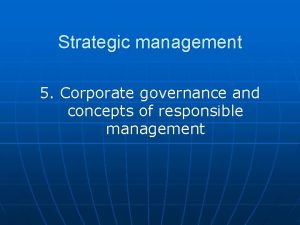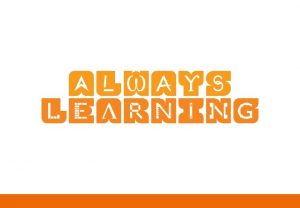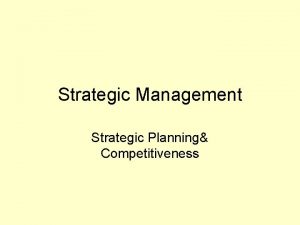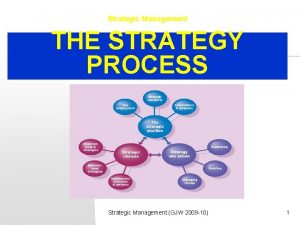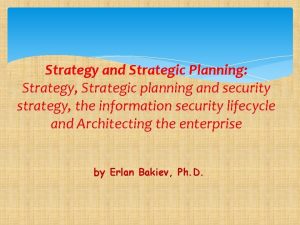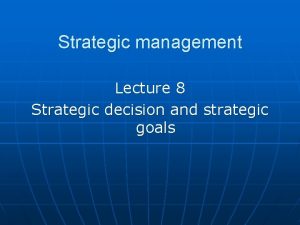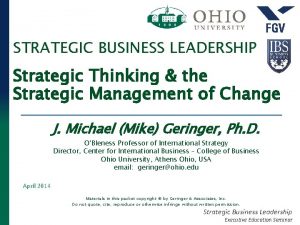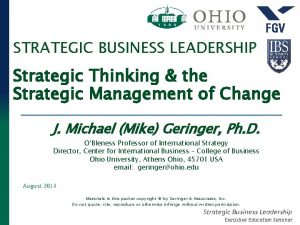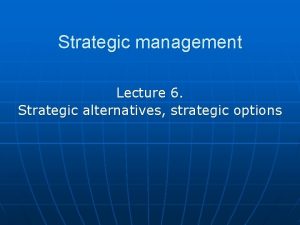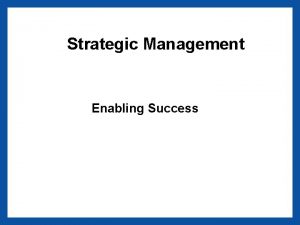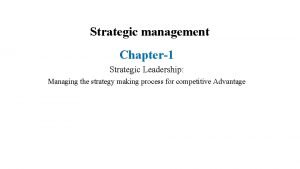STRATEGIC MANAGEMENT UNIT 1 1 What is Strategy











































- Slides: 43

STRATEGIC MANAGEMENT UNIT 1 1

What is Strategy? “A unified, comprehensive, and integrated plan designed to ensure that the basic objectives of the enterprise are achieved. ” (Glueck, 1980) Dr. VJK November 24 – 28, 2008

Strategic Management • The larger vision that guides the activities of managers and other employees in an organization • The set of decisions and actions used to formulate and implementing the strategies • The process of establishing and sustaining competitive advantage 3

Strategic Management Definition Art & science of formulating, implementing, and evaluating, crossfunctional decisions that enable an organization to achieve its objectives.

DRIVE SMART Long-term goals should be: D irectional R ealistic I nspirational V isible E ncompassing Short & intermediate goals should be: S pecific M easurable A ttainable R ewarding T imed

Strategy Formulation Vision & Mission External Opportunities & Threats Internal Strengths & Weaknesses Long-Term Objectives Alternative Strategies Strategy Selection

Strategy Implementation Annual Objectives Policies Employee Motivation Resource Allocation

Benefits of Strategic Management Financial Benefits • Improvement in sales • Improvement in profitability • Productivity improvement

Benefits of Strategic Management Non-Financial Benefits • Improved understanding of competitors strategies • Enhanced awareness of threats • Reduced resistance to change • Enhanced problem-prevention capabilities

Traditional Flow of Strategic Management Top Management Subsidiary Management Functional Management Operating Management Employees

Modern Flow of Strategic Management Top Management Subsidiary Management Functional Management Operating Management Employees


Strategic Management Process Task 1 Task 2 Task 3 Task 4 Task 5 Develop a Strategic Vision and Mission Set Objectives Craft a Strategy to Achieve Objectives Implement and Execute Strategy Monitor, Evaluate, and Take Corrective Action Revise as Needed Improve/ Change Recycle as Needed

STRATEGIC PLANNING • Strategic Planning is the managerial process of creating and maintaining a fit between the organization’s objectives and resources and the evolving market opportunities. • Strategic planning is on going, not used just when considering major changes. • It is the determination of the long term goals and objectives of an enterprise. 14

Levels of Strategic Planning • Corporate level strategic planning – Expansion, stability, retrenchment, combination • Business Level Strategic planning (SBU)Meeting competition, protecting market share, profits of SBU • Functional level strategic planning – Operations, financial, marketing, HR

Strategic Planning • Rational planning by top management? Basic Strategic Planning Model Defining the Mission and Setting Top-Level Goals External Analysis of Opportunities and Threats Internal Analysis of Strengths and Weaknesses Selection of Appropriate Strategies Implementation of Chosen Strategies

Features of Strategic Planning • • It is high level It is general It is long term It affects the whole organization

Benefits of strategic planning • • • Improved sales, profitability, and productivity Provides a road map Utilizes resources in best possible manner Firm can respond to environmental changes Better informed decisions Creates framework for internal communication Dr. VJK November 24 – 28, 2008

Ctd… • • Objective view of management problems Improved coordination and control activities Encourages forward thinking Minimizes adverse effects Dr. VJK November 24 – 28, 2008

Types of Planning

Strategic Planning Process

Strategic Planning Flow Chart Mission Plan For Planning • Purpose • Values Stakeholders • External • Internal Assess Mandates External & Internal Assessment • SWOT Vision Define Strategic Issues For the Business Plan of Action Strategy Implementation and Assessment

Strategic, Tactical, Operational plans Strategic n. Long range n 3 or more years n. Top mgmt n. Broad objectives n. Focus on planning & co-ordination Tactical n. Intermediate n 2 Plan -3 years n. Middle level mgmt n. Integrates depts n. Focus on coordination Operational n. Short range plan n 1 year n. Low level n. Covers day to day activities n. Focus on control

• Strategy: Comprehensive plan designed to ensure that basic objectives of an enterprise are achieved • Tactics: Action plans of specific, step by step methods by which strategies are executed • Policy: Offers guidelines for managers to take appropriate decisions

Strategic Intent Leveraging of firm’s resources, capabilities and competencies to accomplish the firm’s vision, mission and objectives in a competitive environment

Hierarchy of Strategic Intent Most Integrative Vision Fewest in number Mission Objectives Goals Plans Most Specific Greatest in number

Vision Vividly descriptive image of what a company wants to be in future • It should – Clarity – Reachable – Brevity

Company Vision • • Massively inspiring Overarching Long-term Driven by and evokes passion Company vision Hierarchy of Goals Dr. VJK November 24 – 28, 2008

Mission • Mission or Purpose is a precise description of what an organization does. • It should describe the business the organization is in. • It is a definition of “why” the organization exists currently. Dr. VJK November 24 – 28, 2008

Mission statements • Purpose of the company • Basis of competition and competitive advantages • More specific than vision • Focused on the means by which the firm will compete Company vision Mission statements Hierarchy of Goals

Features of good mission statement • • • Answers the question “ What is our business” Differentiates the company from competitors Exciting and inspiring Not time bound Represents the whole thrust of the firm

9 Components of a Mission Statement • • • Customers Products or Services Markets Technology Concern for Survival, Growth, & Profitability Philosophy Self-Concept Concern for Public Image Concern for Employees

How does mission help • • Reference Point Educative Value Motivating Force Productive use of resource

Strategic objectives • Operationalize the mission statement • Provide guidance on how the organization can fulfill or move toward the “higher goals” • More specific • Cover a more well-defined time frame Company vision Mission statements Strategic objectives Hierarchy of Goals

EXAMPLE: STRATEGIC OBJECTIVES A bigger market share Lower costs relative to key competitors Broader or more attractive product line than rivals A stronger reputation with customers than rivals Better customer service than rivals Recognition as a leader in technology and/or product innovation • Ability to compete in international markets • A higher, more secure industry rank • • •

Example Financial Objectives • Increase sales growth 6 to 8% per year • Cut costs by 5% per year every year • Increase annual dividends to shareholders by 5% per year • Achieve highest Return on Investment (ROI) in industry

Dimensions of Strategic Goals • Profitability • Productivity • Physical & Financial Resources • Managerial Performance & Development • Worker Performance & Attitude • Innovation • Market Standing • Social Responsibility

SOME SAMPLE STRATEGIC INTENTS FORD Motor Company Our Vision: to become the world's leading company for automotive products and services. Our Mission: we are a global, diverse family with a proud heritage, passionately committed to providing outstanding products and services. Our Values: We do the right thing for our people, our environment and our society, but above all for our customers.

SOME SAMPLE STRATEGIC INTENTS TOYOTA MOTOR Corporation Slogan: Toyota will continue to innovate relentlessly to ensure further growth. Mission: Toyota seeks to create a more prosperous society through automotive manufacturing. Vision: Toyota aims to achieve long-term, stable growth in harmony with the environment, the global economy, the local communities it serves, and its stakeholders.

Values • They are statements about how the organization will value customers, suppliers, and the internal community. • Value statements describe actions which are the living enactment of the fundamental values held by most individuals within the organization.

The Value Chain Raw Materials Operations Distribution Sales and Marketing Support Activities Customer Service Product R &D, Technology, Systems Development Human Resource Management General Administration

The following are examples of values: Ambition, competency, individuality, equality, integrity, service, responsibility, accuracy, respect, dedication, improvement, enjoyment/fun, loyalty, credibility, honesty, teamwork, excellence, accountability, empowerment, efficiency, collaboration

To Conclude… • • • vision for your future Mission defines what you want to do Values shape your action Strategies zero in on key success approaches Goals and action plans to guide your daily, weekly and monthly actions.
 Resource based model
Resource based model Analysing the 6 strategic options megxit
Analysing the 6 strategic options megxit Process of crafting and executing strategy
Process of crafting and executing strategy Functional strategy and strategic choice
Functional strategy and strategic choice What is corporate strategy in strategic management
What is corporate strategy in strategic management Directional strategies in strategic management
Directional strategies in strategic management Corporate level cooperative strategy
Corporate level cooperative strategy Strategic meetings management program
Strategic meetings management program Hit another home run strategy
Hit another home run strategy Functional level strategy
Functional level strategy Strategic fit vs strategic intent
Strategic fit vs strategic intent Strategic substitutes
Strategic substitutes Unit 6 review questions
Unit 6 review questions Entry strategy and strategic alliances
Entry strategy and strategic alliances Factors affecting strategic choice
Factors affecting strategic choice Market entry modes for international businesses (chapter 7)
Market entry modes for international businesses (chapter 7) Making strategy: mapping out strategic success
Making strategy: mapping out strategic success Entry strategy and strategic alliances
Entry strategy and strategic alliances Formulation of functional strategy
Formulation of functional strategy Business strategy innovation and strategic entrepreneurship
Business strategy innovation and strategic entrepreneurship Corporate strategy and business strategy
Corporate strategy and business strategy Strategy and organization in the international firm
Strategy and organization in the international firm Example of chase strategy
Example of chase strategy Multidomestic marketing strategy
Multidomestic marketing strategy Aligning hr strategy with business strategy
Aligning hr strategy with business strategy Liability of foreignness
Liability of foreignness Strategy formulation vs strategy implementation
Strategy formulation vs strategy implementation Top-down listening strategy is a listener-based strategy.
Top-down listening strategy is a listener-based strategy. Multinational strategy vs global strategy
Multinational strategy vs global strategy What is strategic investment unit
What is strategic investment unit Business unit strategic planning process
Business unit strategic planning process Strategic business unit structure
Strategic business unit structure Top management and middle management
Top management and middle management Management pyramid
Management pyramid Basic concepts of management
Basic concepts of management Five tasks of strategic management
Five tasks of strategic management Liberta hax
Liberta hax Balanced scorecard meaning
Balanced scorecard meaning Strategic management concepts in the public sector
Strategic management concepts in the public sector Formality in strategic management
Formality in strategic management Sfas matrix template
Sfas matrix template Strategic management lecture
Strategic management lecture Business policy game
Business policy game What is ownership
What is ownership




